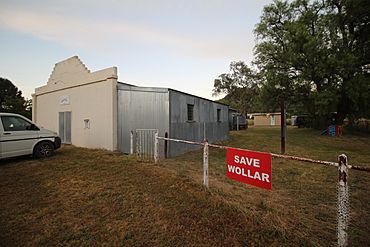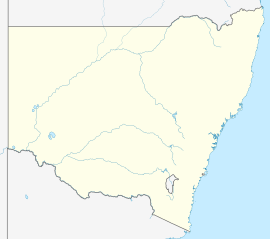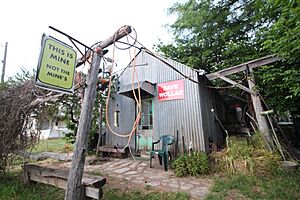Wollar facts for kids
Quick facts for kids WollarNew South Wales |
|
|---|---|

The Wollar Memorial Hall, built in 1955.
|
|
| Population | 69 (2016 census) |
| Postcode(s) | 2850 |
| Location | |
| LGA(s) | Mid-Western Regional Council |
| State electorate(s) | Upper Hunter |
| Federal Division(s) | Parkes |
Wollar is a small village in New South Wales, Australia. It is located about 316 kilometers (196 miles) northwest of Sydney, the state capital. Wollar is also about 48 kilometers (30 miles) northeast of Mudgee, a larger town. The village is close to the Goulburn River National Park.
In 2006, Wollar and the areas around it had a population of 304 people. By 2016, the village population had dropped to just 69 people living in 50 homes. This change happened because a mining company bought many properties in the village.
The land around Wollar is approved for exploring and digging for coal by the government. A company from the United States called Peabody Energy runs the nearby Wilpinjong open-cut coal mine. This company has bought almost all the houses, land, and even churches in Wollar. This has caused many people to move away from the village.
Contents
Wollar's Past: A Look Back
First People: The Wiradjuri
The land where Wollar is located was originally home to the Wiradjuri people. The nearby Goulburn River, which Wollar Creek flows into, was an important path for Aboriginal people. They used it to travel between the inland areas and the Hunter Valley. The name 'Wollar' comes from the Wiradjuri language and means 'rock waterhole'.
Early European Settlement
In 1830, a man named Richard Fitzgerald started paying a land tax for a large piece of land on Wollar Creek. This land was given to him by the Governor of New South Wales in 1824. Fitzgerald had arrived in Australia as a convict in 1791. He became very skilled in farming and was given important jobs in public agriculture. By the 1830s, he was a rich landowner.
When Richard Fitzgerald passed away in 1840, his son Robert took over the land. Robert Fitzgerald already owned a lot of land for grazing animals. He made the Wollar property, called 'Wandoona', much bigger, covering 5,000 acres. The area around Wollar Creek became a popular camping spot for stockmen traveling to Mudgee and Gulgong.
The Village Begins
In 1868, the government officially set aside land for the village of Wollar and its surrounding areas. In 1873, a spot was chosen for a Catholic church in Wollar. A wooden church was built there in 1875. Around the same time, a wooden Anglican church was built on the other side of Wollar Creek.
In 1874, Margaret Willoughby was given a license to run the Old Wollar Inn. A few years later, in 1877, the Wollar Inn and its buildings were put up for sale.
A Time of Worry
In July 1900, Wollar became a place of much attention for the police and newspapers. This was after two Aboriginal men, Jimmy Governor and Jack Underwood, were involved in a serious event near Gilgandra. Jimmy Governor's mother and younger siblings were living in Wollar at the time.
People in Wollar were very worried. Visitors to the town saw men carrying weapons, looking for any sign of the men. Police brought all the local Aboriginal people into the town to keep an eye on them. At night, they were kept in a hall for safety. Many families from Wollar Creek also came into town, filling every available space.
Police were especially careful about Jack Governor, Jimmy's next oldest brother. Five strong Aboriginal men, including Jack, were held at the Wollar police station for their own safety and the public's. Later, these men were taken to Mudgee. In September 1900, it was decided to send the Aboriginal people from Wollar to a Mission Station near Brewarrina. The women and children, including members of the Governor family, were taken to Mudgee and then by train to Brewarrina.
Growing and Changing
In 1903, a visitor noted that Wollar was a quiet place. Its streets were covered in grass, and cattle and horses grazed there. The writer thought Wollar would likely stay small or even shrink.
In March 1905, a new Catholic church opened in Wollar. It replaced the older wooden church from 1875. This new church, called St. Laurence O’Toole Catholic Church, was designed by architect Harold Hardwick. It was built from rough-cut sandstone from a nearby hill. The church's ceiling had special embossed tin panels. Today, this church is no longer used for services and is owned by Peabody Energy, the mining company.
In 1914, the wooden Anglican church was also replaced with a sandstone building. St. Luke’s Anglican church, with its unique top edges, was also designed by Harold Hardwick. In 2009, the Anglican Church removed the church's fittings, pews, and stained-glass windows. They put the building up for sale without asking the local church members. Peabody Energy bought this church too.
Shale Oil Efforts
In May 1930, a company called Australian Imperial Shale Oil Co. Ltd. bought 400 acres of land near Wollar. This land was said to have "millions of tons of shale, very rich in oil." The company planned to get petrol from this shale. They built a workshop and started digging a tunnel.
In 1935, the company showed visitors how they could get oil from shale using a new system. They claimed it was very cheap to mine the shale and get the oil. However, the Australian government later found that getting oil from coal in Australia would be too expensive without a lot of government help. By 1939, the Australian Imperial Shale Oil Company's land, buildings, and machines were put up for sale.
Wilpinjong Coal Mine
The Wilpinjong open-cut coal mine is about six kilometers (3.7 miles) northwest of Wollar village. It is owned by Wilpinjong Coal Pty Ltd, which is part of the US-based Peabody Energy company. The mining work started in 2006 and is planned to continue until 2027. In 2014, the mine was allowed to expand its digging area.
The coal from the Wilpinjong mine is used to power electricity plants like Bayswater and Liddell. It is also sent to countries in Asia from the Port of Newcastle.
Peabody Energy describes itself as a "leading coal producer." However, the company has been known for disagreeing with climate science. When Peabody Energy went through bankruptcy in 2016, documents showed that they had given money to groups and scientists who questioned climate change.
Effects of Coal Mining
Since mining began in 2006, Peabody's company, Wilpinjong Coal, started buying homes and land in Wollar. This included two churches. As a result, the number of people living in the village went down. The Wollar Public School closed in 2018. The local Rural Fire Service also closed, and health services stopped. By November 2020, the mining company owned almost all the properties in the village. Only one house and a piece of land were still privately owned. The owner of that house has not agreed to sell to Peabody.
In 2013, Wilpinjong Coal was accused of breaking its environmental rules. They were said to be using heavy machines during bad weather. A local environmental group showed photos from Wollar residents. These photos showed a lot of dust pollution coming from the mine and blowing through the village.
In November 2020, the NSW government looked into releasing more land near Wollar for coal exploration. This new area was about 80 square kilometers (31 square miles) and surrounded Wollar village. In April 2021, the Deputy Premier announced that this land was released for "potential coal exploration." However, a local group, the Wollar Progress Association, said the government did not properly check the social, environmental, and economic effects on the community. They said this was required by the government's own rules for new coal mines.



